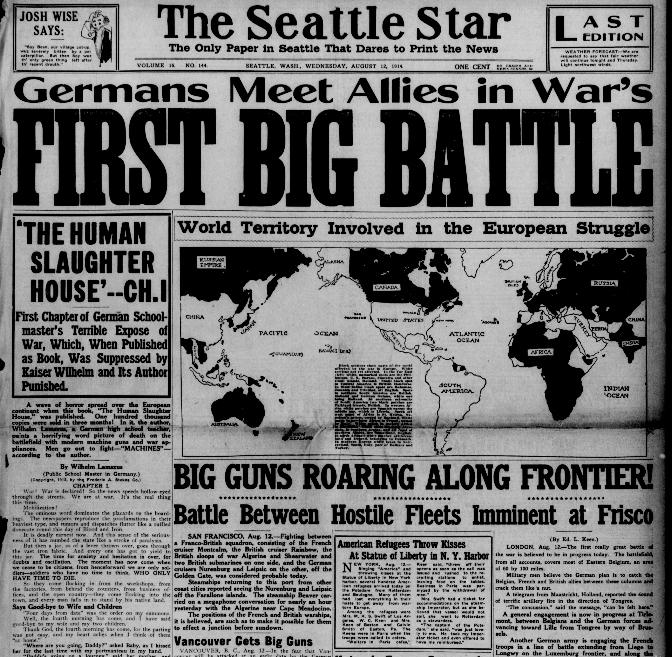|
Moderated by NW Okie! |
Volume 16 , Issue 262014Weekly eZine: (374 subscribers)Subscribe | Unsubscribe Using Desktop... |
1914 - Germans Meet Allies In War's First Big Battle

It was a hundred years ago today, Wednesday, 12 August 1914, that we find the front page headlines of The Seattle Star stated Germans Meet Allies in War's First Big Battle. Guns were roaring along frontier between hostile fleets imminent at Frisco.
London, Aug. 12 (1914) -- The first really great battle of the war was believed to be in progress 12 August 1914. The battlefield, from all accounts, covered most of eastern Belgium, an area of 60 to 100 miles. A telegram from Maastricht, Holland, reported the sound of terrific artillery fire in the direction of Tongres.
"The concussion," said the message, "can be felt here." A general engagement was then in progress at Tirlemont, between Belgians and the German forces advancing toward Lille from Tongres by way of Brussels.
Another German army was engaging the French troops in a line of battle extending from Liege to Longwy on the Luxemburg frontier, and along the Franco-German frontier to Switzerland.
With Cavalary raiders screening the entire front, the Germans had brought modern field artillery to bear on the French forces in the vicinity of Longwy, and were attempting to force an entrance through the gap north of Verdun.
Another engagement was reported to be in progress at Mulhausen, in the south of Alsace-Lorraine, where the French were said to have withstood a terrific onslaught by the Germans, who used Krupp field pieces of tremendous range with deadly effect.
The forts at Liege were still holding out, but the invading Germans had established railroad communication with the rear and were bringing up men and supplies and big guns.
It was thought the allies had moved to the defense of Brussels. German aviators flew over the city on that day and it was thought they located the allies' position.
The London Times' military expert gave it as his opinion that one million Germans, with 5,894 pieces of artillery, were in Belgium.
This was the first line of the German strength and did not include the reserves massed in the rear.
The bulk of the kaiser's forces were north of the German province of Lorraine advancing, in the hope of outflanking the French on the north. There were views expressed that the allies could prevent this. But it would be the most frightful, the most destructive collision in modern history.
| View or Add Comments (0 Comments)
| Receive
updates ( subscribers) |
Unsubscribe
| © . Linda Mcgill Wagner - began © 1999 Contact Me | |
